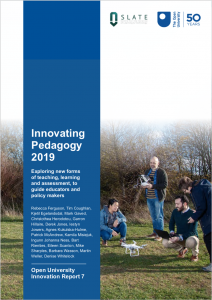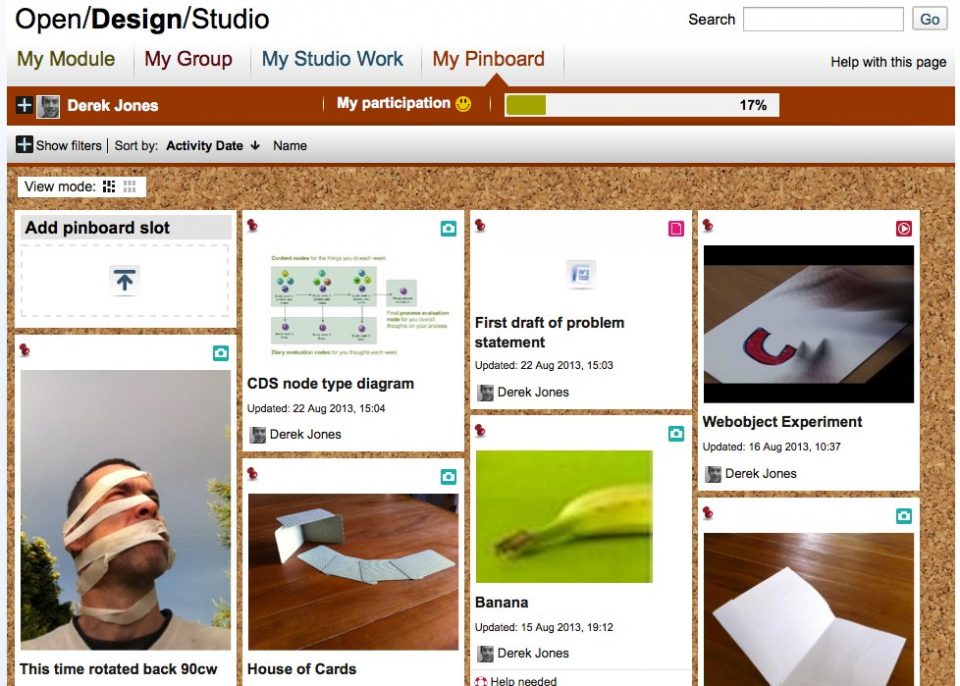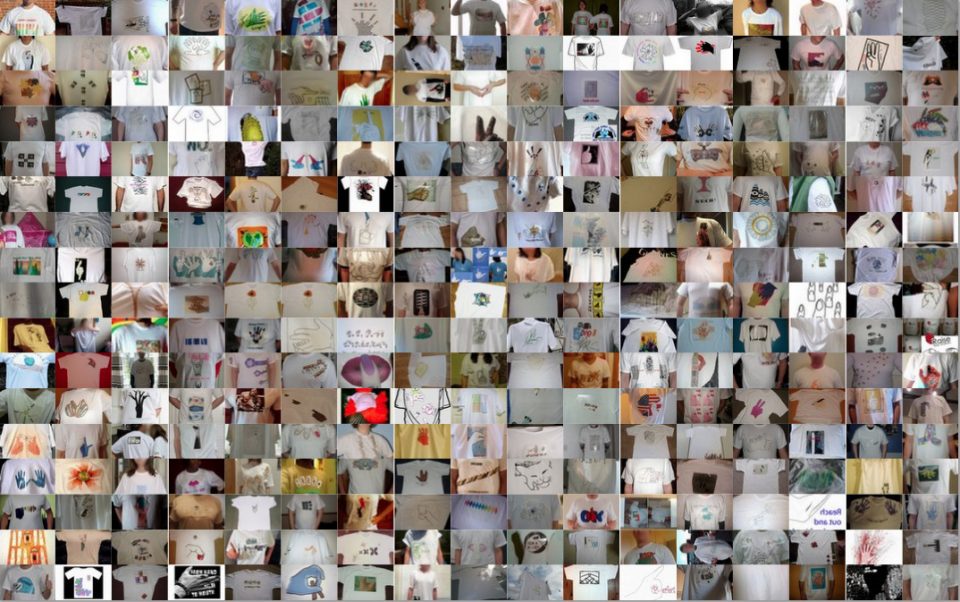 The Innovating Pedagogy report for 2019 has just been published by The Open University (IET) in conjunction with the Centre for the Science of Learning & Technology (SLATE), University of Bergen, Norway.
The Innovating Pedagogy report for 2019 has just been published by The Open University (IET) in conjunction with the Centre for the Science of Learning & Technology (SLATE), University of Bergen, Norway.
The Design Group have one of the sections on Virtual Studios (Section 7!)
So I thought I’d share a couple of the stranger results from our recent research into virtual design studios (papers at the bottom of the post). This research is on the back of almost 15 years of using virtual studios and, before that, nearly 50 years of providing design education at a distance (more on this later in the year).
Design at the OU is studied as a practice – not just as a subject. To support this we use a range on tools, one of which is our online studio, OpenDesignStudio. In this studio a student can see the work of hundreds of other students, organise their work and also have their own personal pinboard and tutor group area. Think of it as Pinterest for distance design education…
Just browsing the studio, checking out other students’ work, is the single best predictor of doing well.
To put it technically, we found a moderate-strong positive correlation between legitimate peripheral learning (viewing other students’ slots) and student success, as measured by course results.
To put it less technically, if you’re an OU design student, one of the best things you can do is simply look at other students’ work. Doing this might even be more valuable than making sure you’ve done some of the ‘planned’ learning (but don’t tell your tutor I said that. Even if I am your tutor. Um….).
This is sometimes known as lurking in online spaces and in education it can also be seen as a very passive thing to do. But in design studios it’s known as Listening In and is one of the most important things you can do as a design student. It’s not passive at all…
What we think is happening here is down to some pretty basic human behaviour – our desire (and even need) to engage in social learning, especially through comparison. From an early age we copy and emulate other actions and behaviour but by just calling it copying we give it a really passive definition. In reality, copying is a bit more dynamic because it has to involve the person doing the copying and they tend to be concerned about how they are doing.
That means that people don’t just copy other people – they do it with a purpose (to compare, to confirm, out of curiosity, for fun, etc.). That means won’t be a perfect copy and (hopefully) might even be adapted positively for the person doing the copying.
And that leads to some pretty complex behaviours and unique outcomes in OpenStudio.
Students don’t behave the way teachers expect them to – and they don’t look at what teachers would look at.
To put it technically, we found significant divergence from statistically stable activity points when comparing individual to group student behaviour. Individual activity patterns revealed some sub-types of behaviour but some statistical deviations remain unexplained. We also identified reasonably significant deviation between novice and expert attentions to student work.
To put it not technically, there are some important things that happen in any course (like assessments) that almost all student do. But when you look at what students actually do (in detail) it’s not like the big statistical picture at all. Almost all students get there in the end but how they do it is rarely by the planned (or even predicted) route.
Having said that, you can use ‘human methods’ to classify certain types (for example, ‘ahead of schedule’, ‘late starter’, and ‘the deadline’s tomorrow?’) But even within these, the statistical patterns are individual in unpredictable ways. Most tutors and students will recognise some of these patterns as examples of the huge range of things that can get in the way of continuing study – there’s never a single reason and some of the shapes we have seen suggest that we need to look at overlaps of patterns to make any sense of them.
The other strange finding was: what teachers and experts think students should be looking at (for their own good, obviously) is not what they are actually looking at. For this, and quite a number of weird behaviours around assessments, we still have absolutely no explanation for (we have filed these under the ‘areas of potential future research’. It’s an academic thing).
So what?
The point about this is a pretty obvious but important one. All these results, despite not being predicted are not really too surprising: real learning behaviour is complex and highly dependent on the person doing the learning. Learning (proper mind-changing learning) is a complex and messy business and, when you add a complex and messy subject on top of that, you get : mess x complexity squared.
So what’s truly incredible here is that we are able to do this at all.
For me, this project has highlighted two things: Firstly, just how much we rely utterly on our students to become active learners from the very start. Design remains a mainly active subject, meaning that it cannot only be taught in terms of information and concept – it also has to be practised and experienced. And then that experience has to feed back on itself to do the learning. Not an easy thing to ask hundreds of novice design students.
Secondly, the other critical component is the Supported Open Learning model – small tutor groups, active tuition support, face to face dayschools, formative tuition assessment, etc. It’s these opportunistic and emergent learning components that are absolutely critical in ensuring that opportunities for learning brought by the student are not wasted.
The consequence of this is that the studio is more than just the tool, OpenDesignStudio – it is the community of practice, the tutors, the learning design, the emergent activity, the character, and all that other complex social stuff that makes any other design studio.



Leave a Reply